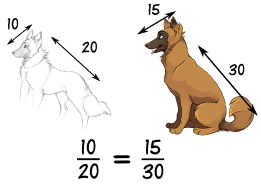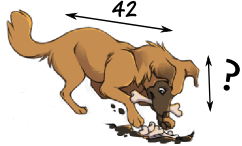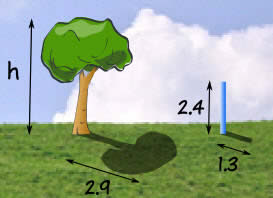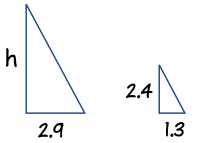RATIO
A ratio is simply a fraction. The following notations all express the ratio of x to y=> $x : y$ , $ x ÷ y$ , or $x/y$.
In the ratio x : y, we call a as the first term or antecedent and b, the second term or consequent.
Writing two numbers as a ratio provides a convenient way to compare their sizes. For example, since $3/π < 1$, we know that 3 is less than π.
A ratio compares two numbers. Just as you cannot compare apples and oranges, so the numbers you are comparing must have the same units.
For example, you cannot form the ratio of 2 feet to 4 meters because the two numbers are expressed in different units—feet vs. meters.
Example 1: What is the ratio of 2 feet to 4 yards?
(A) 1 : 2 (B) 1 : 8 (C) 1 : 7 (D) 1 : 6 (E) 1 : 5
The ratio cannot be formed until the numbers are expressed in the same units. Let’s turn the yards into feet.
Since there are 3 feet in a yard, 4 yards = 4 * 3 feet = 12 feet .
Forming the ratio yields $\text"2 feet"/\text"12 feet" = 1/6 $ or $1 : 6$
The answer is (D).
Note. Taking the reciprocal of a fraction usually changes its size. For example,
$3/4 ≠ 4/3$
So order is important in a ratio=> 3:4 ≠ 4:3.
Rule: The multiplication or division of each term of a ratio by the same non-zero number does not affect the ratio.
Ex. 4 : 5 = 8 : 10 = 12 : 15.
Also, 4 : 6 = 2 : 3.
Proportion:
The equality of two ratios (fractions) is called proportion. If a : b = c : d, we write a : b :: c : d and we say that a, b, c, d are in proportion.
Here a and d are called extremes, while b and c are called mean terms.
$$\text"Product of means = Product of extremes"$$
Thus, $$a : b :: c : d ⇔ (b * c)= (a * d)$$
Fourth Proportional:
If a : b = c : d, then d is called the fourth proportional to a, b, c.Third Proportional:
a : b = c : d, then c is called the third proportional to a and b.Mean Proportional:
Mean proportional between a and b is ab.Comparison of Ratios:
We say that $(a : b) > (c : d) ⇔ a/b > c/d$Compounded Ratio:
The compounded ratio of the ratios: $(a : b), (c : d), (e : f) is (ace : bdf)$Duplicate Ratios:
Duplicate ratio of $(a : b)$ is $(a^2 : b^2)$Sub-duplicate ratio of $ (a : b)$ is $(a^{1/2} : b^{1/2})$
Triplicate ratio of $(a : b)$ is $(a^3 : b^3)$
Sub-triplicate ratio of $(a : b)$ is $(a^{1/3} : b^{1/3})$
If $a/b = c/d$ then, ${a + b}/{a - b} = {c + d}/{c – d}$ [Componendo and Dividendo]u
Variations:
We say that x is directly proportional to y,
if x = ky for some constant k and we write, $x ∝ y$
We say that x is inversely proportional to y,
if xy = k for some constant k and we write, $x ∝ 1/y$
Proportions
Proportion says that two ratios (or fractions) are equal.
Example:

The ratios are the same, so they are in proportion.
When things are "in proportion" then their relative sizes are the same.
| Here you can see that the ratios of head length to body length are the same in both drawings. So they are proportional. Making the head too long or short would look bad! |
 |
Working With Proportions
NOW, how do we use this?
Example: you want to draw the dog's head, and would like to know how long it should be:

| ? | = | 10 |
| 42 | 20 |

Multiply across the known corners,
then divide by the third number
And you get this:then divide by the third number
? = (42 × 10) / 20 = 420 / 20 = 21
So you should draw the head 21 long.Using Proportions to Solve Percents
A percent is actually a ratio! Saying "25%" is actually saying "25 per 100":
| 25% = | 25 |
| 100 |
We can use proportions to solve questions involving percents.
First, put what you know into this form:
| Part | = | Percent |
| Whole | 100 |
Example: what is 25% of 160 ?
The percent is 25, the whole is 160, and we want to find the "part":| Part | = | 25 |
| 160 | 100 |
Find the Part:
Example: what is 25% of 160 (continued) ?
| Part | = | 25 |
| 160 | 100 |

Part = (160 × 25) / 100 = 4000 / 100 = 40
Answer: 25% of 160 is 40.Note: you could have also solved this by doing the divide first, like this:
Part = 160 × (25 / 100) = 160 × 0.25 = 40
Either method works fine.
We can also find a Percent:
Example: what is $12 as a percent of $80 ?
Fill in what you know:| $12 | = | Percent |
| $80 | 100 |

Percent = ($12 × 100) / $80 = 1200 / 80 = 15%
Answer: $12 is 15% of $80
Or find the Whole:
Example: The sale price of a phone was $150, which was only 80% of normal price. What was the normal price?
Fill in what you know:| $150 | = | 80 |
| Whole | 100 |

Whole = ($150 × 100) / 80 = 15000 / 80 = 187.50
Answer: the phone's normal price was $187.50Using Proportions to Solve Triangles
You can use proportions to solve similar triangles.
Example: How tall is the Tree?
Sam tried using a ladder, tape measure, ropes and various other things, but still couldn't work out how tall the tree was.| But then Sam has a clever idea ... similar triangles! Sam measures a stick and its shadow (in meters), and also the shadow of the tree, and this is what he gets: |
 |
Now Sam makes a sketch of the triangles, and writes down the "Height to Length" ratio for both triangles:
|
 |
Multiply across the known corners, then divide by the third number:
h = (2.9 × 2.4) / 1.3 = 6.96 / 1.3 = 5.4 m (to nearest 0.1)
Answer: the tree is 5.4 m tall.And he didn't even need a ladder!
The "Height" could have been at the bottom, so long as it was on the bottom for BOTH ratios, like this:
Let us try the ratio of "Shadow Length to Height":
|
 |
h = (2.9 × 2.4) / 1.3 = 6.96 / 1.3 = 5.4 m (to nearest 0.1)
It is the same calculation as before.A "Concrete" Example
Ratios can have more than two numbers!
For example concrete is made by mixing cement, sand, stones and water.
 |
A typical mix of cement, sand and stones is written as a ratio, such as 1:2:6. You can multiply all values by the same amount and you will still have the same ratio.
10:20:60 is the same as 1:2:6
So if you used 10 buckets of cement, you should use 20 of sand and 60 of stones. |
Example: if you have just put 12 buckets of stones into a
wheelbarrow, how much cement and how much sand should you add to make a 1:2:6 mix?
Let us lay it out in a table to make it clearer:
| Cement | Sand | Stones | |
|---|---|---|---|
| Ratio Needed: | 1 | 2 | 6 |
| You Have: | 12 |
You can see that you have 12 buckets of stones but the ratio says 6.
That is OK, you simply have twice as many stones as the number in the ratio ... so you need twice as much of everything to keep the ratio.
Here is the solution:
| Cement | Sand | Stones | |
|---|---|---|---|
| Ratio Needed: | 1 | 2 | 6 |
| You Have: | 2 | 4 | 12 |
And the ratio 2:4:12 is the same as 1:2:6 (because they show the same relative sizes)
Why are they the same ratio? In the 1:2:6 ratio there is 3 times more Stones as Sand (6 vs 2), and in the 2:4:12 ratio there is also 3 times more Stones as Sand (12 vs 4) ... similarly there is twice as much Sand as Cement in both ratios.
That is the good thing about ratios. You can make the amounts bigger or smaller and so long as the relative sizes are the same then the ratio is the same.
So the answer is: add 2 buckets of Cement and 4 buckets of Sand.
No comments:
Post a Comment